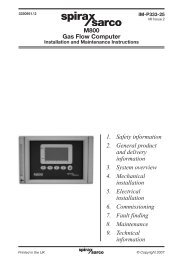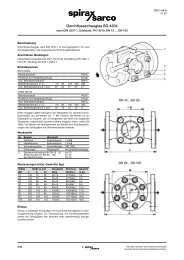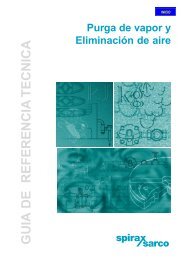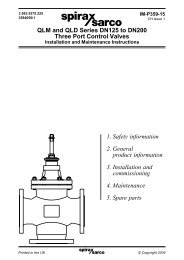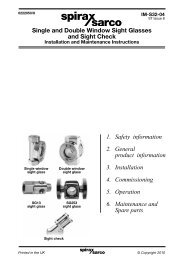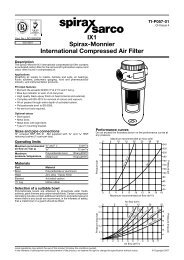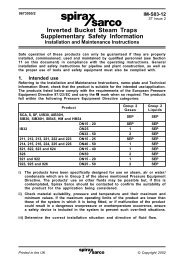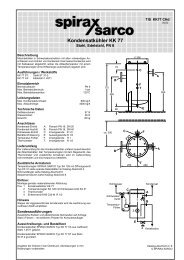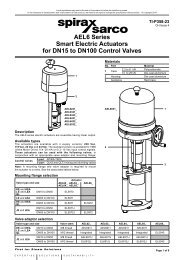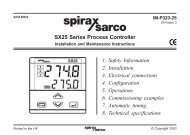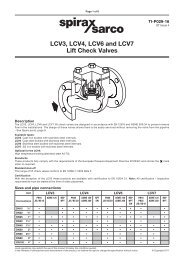2000 Hook-up Book - Spirax Sarco
2000 Hook-up Book - Spirax Sarco
2000 Hook-up Book - Spirax Sarco
You also want an ePaper? Increase the reach of your titles
YUMPU automatically turns print PDFs into web optimized ePapers that Google loves.
valve at the outlet of the pump<br />
body. At the end of the discharge<br />
stroke, an internal mechanism<br />
changes over, closing the pressurizing<br />
inlet valve and opening<br />
an exhaust valve. The pressurizing<br />
gas is then vented to<br />
atmosphere, or to the space from<br />
which the condensate is being<br />
drained. When the pressures are<br />
equalized, condensate can flow<br />
by gravity into the pump body to<br />
refill it and complete the cycle.<br />
As the pump fills by gravity<br />
only, there can be no cavitation<br />
and this pump readily handles<br />
boiling water or other liquids compatible<br />
with its materials of<br />
construction.<br />
The capacity of the pump<br />
depends on the filling head available,<br />
the size of the condensate<br />
connections, the pressure of the<br />
operating steam or gas, and the<br />
total head through which the condensate<br />
is lifted. This will include<br />
the net difference in elevation<br />
between the pump and the final<br />
discharge point; any pressure difference<br />
between the pump<br />
receiver and final receiver; friction<br />
in the connecting pipework, and<br />
the force necessary to accelerate<br />
the condensate from rest in the<br />
pump body <strong>up</strong> to velocity in the<br />
discharge pipe. Tables listing<br />
capacities under varying conditions<br />
are provided in the catalog<br />
bulletins.<br />
Piping Requirements<br />
Depending <strong>up</strong>on the application,<br />
the Pressure Powered Pump <br />
body is piped so that it is vented<br />
to atmosphere or, in a closed system,<br />
is pressure equalized back<br />
to the space that it drains. This<br />
allows condensate to enter the<br />
pump but during the short discharge<br />
stroke, the inlet check<br />
valve is closed and condensate<br />
accumulates in the inlet piping. To<br />
eliminate the possibility of condensate<br />
backing <strong>up</strong> into the<br />
steam space, reservoir piping<br />
must be provided above the<br />
pump with volume as specified in<br />
the catalog. A closed system<br />
requires only a liquid reservoir. In<br />
open systems, the vented receiver<br />
serves this purpose as it is<br />
always larger in order to also separate<br />
the flash steam released.<br />
Vented Systems<br />
Condensate from low pressure<br />
heating systems may be piped<br />
directly to a small size Pressure<br />
Powered Pump only when 50<br />
lb/h or less of flash steam must<br />
vent through the pump body. This<br />
does not eliminate the requirement<br />
that there must be enough<br />
piping to store condensate during<br />
the brief discharge cycle. In many<br />
low pressure systems, the reservoir<br />
may be a section of larger<br />
horizontal pipe which is vented to<br />
eliminate flash steam. In higher<br />
pressure, high load systems, the<br />
larger quantity of flash released<br />
requires a vented receiver with<br />
piping adequate to permit complete<br />
separation. To prevent<br />
carryover of condensate from the<br />
Vented Receiver<br />
Pressure<br />
Powered<br />
Pump<br />
Vent<br />
Condensate Pumping<br />
vent line, the receiver should be<br />
sized to reduce flow velocity to<br />
about 10 FPS.<br />
Closed Loop Systems<br />
It is often advisable where larger<br />
condensate loads are being handled<br />
to dedicate a Pressure<br />
Powered Pump to drain a single<br />
piece of equipment. The pump<br />
exhaust line can then be directly<br />
connected to the steam space of<br />
a heat exchanger or, preferably<br />
with air heating coils, to the reservoir.<br />
This allows condensate to<br />
drain freely to the pump inlet and<br />
through a steam trap at the pump<br />
outlet. Only liquid is contained in<br />
the reservoir of a closed loop system.<br />
Fig.II-32 (page 99) illustrates<br />
how the Pressure-Powered pump<br />
functions as a pumping trap, and<br />
use Fig. II-35 (page 101) when<br />
the steam s<strong>up</strong>ply may sometimes<br />
be greater than the return pressure<br />
and a combination<br />
pump/trap is required.<br />
Steam<br />
S<strong>up</strong>ply<br />
Figure 54<br />
Venting of Pump Exhaust and Inlet Receiver Pipe in a<br />
Low Pressure System<br />
Condensate<br />
Return<br />
49<br />
SYSTEM DESIGN



